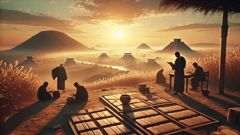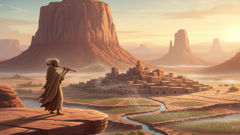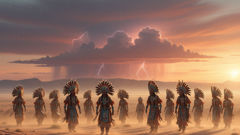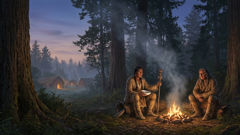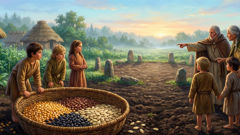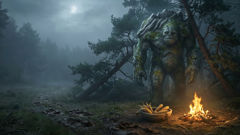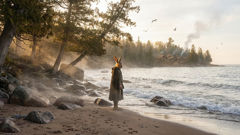Introduction
In the dust-laden air of southern Mesopotamia, where riverbanks bend with the patience of centuries and cities rise like chalky clues from the earth, the past begins to murmur. The hour is uncertain, but the moment is urgent: a team of archaeologists has pried open a sealed world of clay, a library of signs pressed into the memory of people who lived and died long before radio, long before print, long before the idea of a nation stitched its first seams. When they lay out the tablets, coated in dust that shines when a lamp catches it, the room fills with a weight that feels both ancient and intimate, as if a chorus of voices has entered quietly from the walls themselves. These are not mere stones; they are memory made tangible, a chorus of deities and mortals who walked the same earth as the farmers, the potters, the priests, and the merchants who built Ur and Uruk and Lagash. The Anunnaki—names that still echo in the syllables of wind through reed houses—appear in a dozen inscriptions at once, a constellation of beings who arrived from the heavens with calendars and laws, with craft and song, with a sense that time is a ledger and a classroom and a temple in one. They descended because the soil asked for order, because the moon demanded witnesses, because the people needed stories that could hold a village together through drought, flood, famine, and the quiet, stubborn work of growing grain. The tablets do not pretend to be a single cylinder of truth but a stack of voices speaking across ages—Enlil whispering of authority, Enki insisting on water and knowledge, Inanna teaching the art of turning danger into possibility, Ninhursag shaping life from clay and desire. To read them is to learn how a civilization negotiates power with mercy, science with wonder, and empire with mercy. It is to witness a moment when the heavens are not distant but close enough to touch, and when humanity discovers that wisdom arrives not as a single decree but as a shared, patient dialogue between gods and gardeners, scribes and farmers, kings and women by the loom. This introduction gathers the threads of those voices and places them into a single, living narrative: a story about descent, about the birth of memory, and about the stubborn, generous work of civilization.
The Tablets Speak: Voices from the Earthen Scrolls
The excavation continues as a patient prayer rather than a rush to discovery. In the first chapter of the clay, a refrain repeats like water through a reed bed: the Anunnaki descended to adjudicate, to instruct, to measure. The inscriptions tell of a council that gathered on a high platform of wood and stone, a circle that looked down upon a city that had not yet learned to fear the night. The gods spoke in a cadence that had no rhyme in the living tongue of the street, yet the words were clear enough to any scribe who could hear between the lines. Enlil, sovereign of the storm and the city’s order, spoke of boundaries and seasons, of the pulse of harvest and the danger of pride. Enki, the god of water and wisdom, spoke in ripples and wells, insisting that knowledge must be shared as surely as rivers give life to the land. The humans, who would be called by many names in later days, listened—not as servants in fear but as apprentices in awe, ready to be taught the craft of living: how to plant a seed, how to weigh grain, how to reckon time with the stars that scribe their paths across the night.
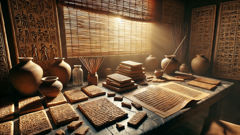
The language of the tablets is not a single instrument but an orchestra of signs—arrayed tokens, wedge-shaped marks, and curved strokes that appear to dance as the clay dries. When the translator’s eye moves along the lines, a narrative emerges that is at once paternal and provisional, as if the gods themselves wanted to see whether their children could keep faith with the promises carved into the earth. The Anunnaki do not merely grant power; they share a design: to shape fields that answer to the rain, to place a city’s gate in the proper orientation to the sun, to impose rules that teach a community to live with one another and with the limits of the soil. In these lines, agriculture and astronomy become brothers, matrimony and law become neighbors, and the temple becomes a school where wonder is the curriculum and restraint is the discipline.
As the tablets spread out on the marble and stone tables, the archaeologists begin to notice a pattern: once the gods set the laws, the people must interpret and re-interpret them as the land changes. The clay remembers drought by thickening its grown grip on root and stem; it remembers renewal by the way it presents new shoots after the flood. The myth is not a single moment but a season of learning—how to read the river’s face, how to ask for rain, how to tell a story that can bind a village across decades. TheAnunnaki are not distant conquerors but mentors who invite conversation, who grant humanity the courage to test the boundaries of craft and courage and then revise those boundaries with humility. In their descent, there is a gift and a test: the gift of tools, calendars, and the sense that wonder can be used to feed, not merely to enthrall. The narrative that unfolds in these lines is a map of civilization, a guide to the way a people become more than a collection of fields and houses; they become a covenant, a community able to weather the unpredictable weather of history.
The voices here are varied and sometimes contradicting, yet there is a coherence in the insistence that wisdom is shared and measured. One tablet speaks of a banquet where bread and beer are offered to the gods and to the people who keep the city alive; another tablet speaks of a drought that tests the loyalty of rulers and the patience of priests. Through it all, the Anunnaki act as both gardeners and engineers, as tacticians and poets, as guardians who permit human ascent while ensuring the sky remains the true master. The section ends with a quiet promise: that the wisdom of these pages—if learned, practiced, and transmitted—will outlive empires and endure in the daily acts of mercy and restraint that keep a town resilient in the face of famine and flood. Paragraph by paragraph, it becomes clear that these are not mere myths but living instructions etched in clay for a people who would someday teach the world the art of listening to creation’s deeper intelligence.
From Heaven to Earth: The Descent and the Craft of Humanity
When the Anunnaki chose to descend, they did not arrive as a single wave but as a council with many faces, each representing a facet of order, knowledge, and care. The tablets describe orders given to land and river, to grain and vine, to the people who would cultivate them. Enki’s voice, watery and sly, speaks of life’s ingredients: clay for skin, breath for spirit, water for memory. He promises that the gods will supply the means of labor and the means of science: the molds that shape bricks, the measurements that determine a plow’s path, the calendars that tell a farmer when to plant and when to harvest. The humans, shown as both eager and imperfect, accept the challenge with a mixture of reverence and restlessness. They crave tools and stories that explain why the rain falls and how to appease the river when it swells beyond its brim.
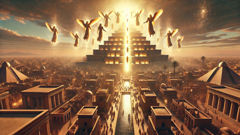
In the narrative’s most enduring moment, the creators birth a new act for their pupils: work. Not toil alone, but purposeful, cooperative work that binds neighbors, kin, and strangers into a city’s daily rhythm. The gods teach hands to fuse copper, to fashion a loom, to mark a boundary with stone that neither fever nor famine will erase. They lay the first roads of cosmopolitan memory: a social contract that binds the temple to the market and the house, the priest to the weaver, the teacher to the child. And yet for all the brilliance and order, the tablets carry a caution: knowledge without mercy becomes brittle, power without restraint becomes a storm. So the descent is not a conquest but a partnership, a test of character and a trust that the human beings can learn to govern themselves with wisdom rather than fear.
As centuries pass within the clay, the stories shift into a living tradition. The Anunnaki become a chorus that visitors hear in the marketplace, a set of names that farmers whisper when they draw water from the canal, a constellation recited by the old priest at the edge of the city’s dawn. The voice of Enlil grows more tempered with time, teaching rulers to seek justice before glory, to measure pride against the needs of the many. Enki’s generosity becomes a measure of generosity in turn, a cultural practice of sharing seeds, knowledge, and dialogue with others who come to learn from this place. The descent fractures into a daily discipline—the discipline of memory. The humans do not merely imitate the gods; they challenge them by creating and preserving their own scripts, their own legal and ceremonial calendars, their own stories of origins that will become the core of a national identity that later ages will call Sumer.
The chapter closes with a quiet, stubborn sense of possibility. The gods depart but leave behind a craft tradition that endures, a memory of a people who learned to listen to the heavens while tending the soil. The Anunnaki’s descent is thus remembered not only as a myth of power but as a practical genesis: a reminder that civilization is a shared experiment, a collaboration whose success rests on humility, curiosity, and the patient work of ordinary people who decide, day after day, to build together. The tablets’ last lines invite the reader to walk the streets of Lagash and Uruk in a mind that can hear both the wind through palm fronds and the whisper of a scribe’s reed pen, speaking across time to say: you are here because someone taught you to listen.
The Covenant of Wisdom: Memory as Tool and Teacher
The myth does not end with the founding of cities or the birth of art and law. It moves deeper, into the moral stance by which a civilization lives with its gods and its neighbors. The Anunnaki’s gift is not merely technology but the ability to remember and to question, to turn a deed into a law and a law into a story that can be taught again and again. In the second century of this narrative’s memory, scribes begin to distinguish between the knowledge that serves the heart and the knowledge that serves hands alone. They begin to ask not only how to do something but why. This is the moment when the myth becomes philosophy and the city becomes a laboratory for ethics: Who deserves mercy? Who must answer for harm done in the name of order? How does one govern with a steady gaze toward the future while honoring the past’s fragile spark?
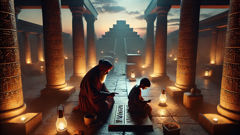
The text suggests a social contract in which every citizen is a co-creator of the world they inhabit. The farmer learns to claim stewardship of the land, the merchant learns to share risks with others, the priest learns to translate the heavens’ moods into practical calendars that guide planting, healing, and seasonal rites. The Anunnaki are invoked not as tyrants but as guardians who demand accountability. When a king’s greed threatens famine, the gods remind him that governance is a service, that authority is a device for preserving life, not for hoarding it. The people learn to organize their lives with a cadence that respects both necessity and wonder: to plant with the rains, to store grain against drought, to write laws that protect the weak, to tell the old stories so that children may practice imagination alongside arithmetic.
And so the narrative’s moral travels outward, from temple precincts to the market stalls, from royal palaces to the humble home. A grandmother by the hearth teaches her grandchild the signs of the zodiac painted on a clay disk; a craftsman in Lagash records a civil dispute with a legal tablet that will outlive the dispute’s heat. In this way, memory itself becomes a tool, a kind of cunning that quiets fear, steadies hands, and invites future generations to participate in the ongoing act of civilization. The Anunnaki’s descent is finally understood as a pedagogy: a patient, generous school in which the sky teaches the ground to wait for rain, and the ground teaches the sky to listen to human longing. The final lines remind the reader that any civilization worth its salt is not a monument to gods alone but a living, breathing dialogue that rises from seed to street to story, forever growing wiser as time travels forward.
Conclusion
The Anunnaki Sumerian myth stands as a living archive: a record of descent that becomes ascent, a reminder that civilization is a shared act of remembering. If you listen closely to the spaces between the signs—the gaps between river and city, between temple and home—you hear the same thought recur: wisdom is not a possession but a practice, passed along by teachers, farmers, poets, and children. The stories of Enki, Enlil, Inanna, and the rest do not exist to exalt power alone; they invite every reader to participate in the ongoing work of building a community that can sustain hope through droughts, wars, and the slow, stubborn arc of history. In this sense, the myth remains a living instrument: a blueprint for listening, a map for stewardship, and a quiet insistence that civilization is possible only when people decide to pass knowledge forward with generosity, courage, and humility. The heavens may have sent the Anunnaki to inaugurate a culture, but it is the humans who continue the work—writing, farming, governing, and telling the stories that will last as long as the mud that cradled our beginnings. This closing thought is not a conclusion so much as a doorway: step through, and you join the long chorus that keeps a city thriving by remembering where it began and who showed it the way.

